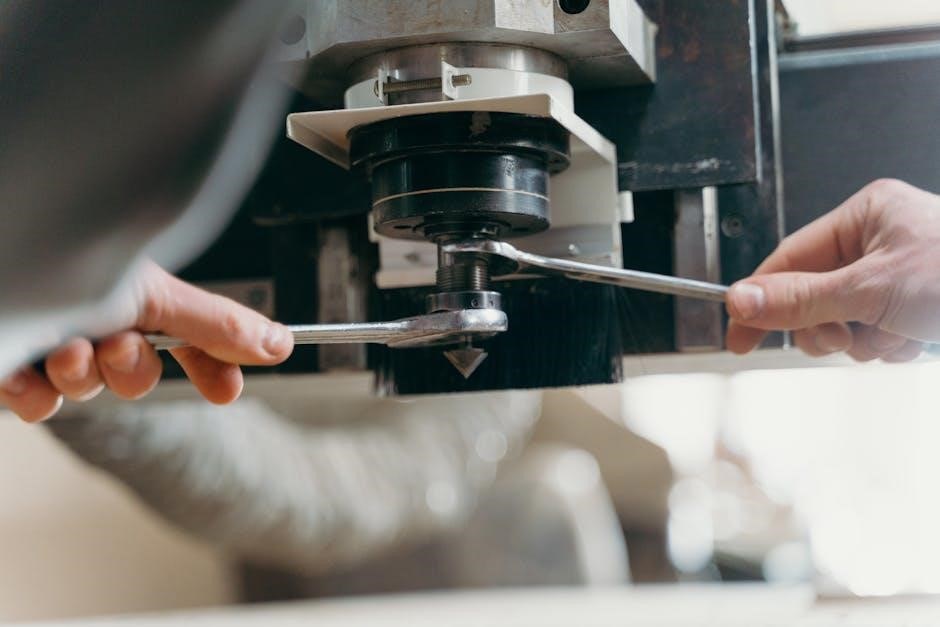The Cessna 182‚ introduced in 1956‚ is a renowned single-engine aircraft celebrated for its reliability and performance. Its popularity spans training‚ recreation‚ and personal aviation‚ making it a cornerstone in general aviation with a comprehensive parts manual ensuring maintenance and repair efficiency.

1.1 Historical Background of the Cessna 182
The Cessna 182‚ introduced in 1956‚ is a single-engine aircraft that has become a cornerstone in general aviation. Known for its durability and versatility‚ it evolved from earlier Cessna models‚ with improvements in design and performance. The 182 gained popularity for its robustness‚ making it ideal for training‚ recreation‚ and personal use. Over the years‚ various models were released‚ including the 182E‚ F‚ and G‚ each offering enhancements in avionics and structural integrity. The development of the parts manual paralleled the aircraft’s evolution‚ providing detailed guidance for maintenance and repairs. This manual has been updated regularly‚ ensuring compatibility with newer models and addressing the needs of mechanics and owners. Its historical significance lies in its role as a trusted resource for maintaining the aircraft’s reliability and performance over decades.
1.2 Design Features and Capabilities
The Cessna 182 is distinguished by its robust design‚ featuring a sturdy all-metal airframe and a reliable Lycoming IO-540 engine. Its fixed tricycle landing gear ensures stability‚ while the cantilever wings provide excellent visibility and performance. The aircraft’s design emphasizes durability‚ with a maximum takeoff weight of 2‚800 pounds and a cruising speed of 140 knots. The parts manual details these components‚ offering insights into their construction and functionality. Advanced avionics in later models enhance navigation and safety‚ supported by comprehensive maintenance guidelines. The 182’s versatility allows it to operate in various environments‚ from paved runways to grass strips‚ making it a favorite among pilots worldwide. Its design and capabilities are well-documented in the parts manual‚ ensuring efficient maintenance and optimal performance.
Overview of the Cessna 182 Parts Manual
The Cessna 182 Parts Manual is a comprehensive guide covering parts identification‚ standard numbering‚ and catalog organization. It spans models from 1961 to 1985 and is available as a PDF.

2.1 Structure and Organization of the Manual
The Cessna 182 Parts Manual is meticulously structured to facilitate easy navigation and efficient parts identification. It begins with an introduction‚ followed by sections dedicated to finish and trim plates‚ upholstery‚ and interior trim. The manual includes detailed alphabetical and numerical indexes‚ ensuring quick access to specific parts. Illustrated parts listings are organized by aircraft systems‚ with corresponding figures and part numbers. The catalog is chronologically arranged‚ covering models from 1961 to 1985‚ and includes serial number ranges for accuracy. The PDF format allows for digital accessibility‚ enabling users to search and reference parts effortlessly. This systematic organization ensures that mechanics and owners can locate and identify components efficiently‚ making it an indispensable resource for maintenance and repairs.
2.2 Purpose and Scope of the Parts Manual
The Cessna 182 Parts Manual is designed to provide detailed information for identifying‚ ordering‚ and replacing parts for the aircraft. Its primary purpose is to assist owners‚ mechanics‚ and technicians in maintaining‚ repairing‚ and upgrading the Cessna 182. The manual covers a wide range of models‚ including the 182‚ 182E‚ F‚ and G‚ spanning production years from 1961 to 1985. It includes comprehensive listings of replacement parts‚ standard numbering conventions‚ and visual identification methods. The scope extends to providing serial number ranges‚ ensuring accuracy in part compatibility. This resource is essential for ensuring aircraft airworthiness and compliance with maintenance standards. By organizing parts catalogically‚ the manual simplifies the process of locating and procuring necessary components‚ making it an indispensable tool for anyone involved in Cessna 182 maintenance.
Parts Identification in the Manual
The Cessna 182 parts manual provides detailed part numbers‚ codes‚ and visual identification methods to ensure accurate component recognition and ordering for maintenance and repairs.
3.1 Understanding Part Numbers and Codes
The Cessna 182 parts manual uses a standardized numbering system to identify components‚ ensuring clarity and precision. Each part number is structured to encode specific information‚ such as the component’s function‚ material‚ or location. For example‚ prefixes denote categories (e.g.‚ “01-” for airframe parts)‚ while suffixes indicate variations or revisions. Codes embedded within the numbers help technicians decode manufacturer details‚ serial ranges‚ and compatibility. This systematic approach allows users to quickly identify and cross-reference parts‚ streamlining maintenance and procurement processes. The manual also includes cross-referencing tools‚ such as numerical and alphabetical indexes‚ to further aid in locating specific components efficiently.
3.2 Visual Identification Methods
The Cessna 182 parts manual incorporates detailed illustrations and diagrams to visually identify components‚ enhancing clarity for maintenance and repair tasks. Each figure corresponds to specific part numbers‚ allowing technicians to locate and verify components accurately. High-resolution images depict assemblies‚ subassemblies‚ and individual parts‚ making it easier to identify items by appearance. Color-coded labels and callouts further assist in distinguishing between similar parts or critical components. This visual approach complements the written descriptions‚ reducing errors and saving time during maintenance. The manual also includes exploded views of complex systems‚ such as engines and avionics‚ to provide a clear understanding of how parts interact and are assembled. These visual aids are essential for ensuring accurate identification and proper installation of aircraft components.

Standard Parts Numbering Conventions
The Cessna 182 parts manual uses a systematic numbering convention‚ incorporating prefixes and suffixes to denote part types‚ materials‚ and specifications‚ aiding in quick identification and organization.
4.1 Explanation of the Numbering System
The Cessna 182 parts manual employs a structured numbering system to identify components accurately. Each part is assigned a unique identifier‚ often combining letters and numbers‚ to denote its category‚ function‚ and specifications. Prefixes indicate the part type‚ such as “AS” for airframe structures‚ while suffixes may specify materials or finishes. For example‚ “AS-1234-A” could represent an airframe component made of aluminum. The numerical index cross-references these codes‚ enabling quick lookup. This system ensures consistency and simplifies maintenance by providing clear‚ standardized references for technicians and mechanics. The manual’s detailed indexing further enhances navigation‚ making it easier to locate specific parts and their corresponding details efficiently.
4.2 Prefixes and Suffixes in Part Numbers
In the Cessna 182 parts manual‚ prefixes and suffixes in part numbers provide critical details about the component’s type‚ material‚ and application. Prefixes‚ such as “AS” for airframe structures or “EL” for electrical components‚ indicate the part’s category. Suffixes‚ like “-A” for aluminum or “-S” for stainless steel‚ denote material specifications. For example‚ “AS-1234-A” identifies an airframe part made of aluminum. These codes ensure precise identification‚ reducing errors in ordering or installation. The system also includes modifiers‚ such as “-L” for left-hand or “-R” for right-hand applications‚ further refining part specificity. This structured approach simplifies maintenance by allowing technicians to quickly decode and locate the correct parts‚ ensuring efficient repairs and compliance with manufacturer standards.

Catalog Organization and Navigation
The Cessna 182 parts manual is organized into sections‚ including an alphabetical index‚ parts listings‚ and numerical index‚ enabling efficient navigation and precise part identification for maintenance.
5.1 Sections and Categories in the Catalog
The Cessna 182 parts manual is divided into clear sections and categories to facilitate easy access to information. These sections include an alphabetical index‚ parts listings‚ and a numerical index‚ ensuring that users can quickly locate specific components. The catalog is further organized by aircraft systems and subsystems‚ such as airframe‚ engine‚ and avionics‚ making it easier to identify and order parts. Each section contains detailed illustrations and descriptions‚ aiding in accurate part identification. Additionally‚ the catalog includes a list of effective pages and revision history‚ ensuring users have the most up-to-date information. This structured approach allows mechanics and owners to efficiently navigate the manual‚ streamlining maintenance and repair processes.
5.2 Indexing Systems for Easy Navigation
The Cessna 182 parts manual incorporates advanced indexing systems to enhance navigation. It features an alphabetical index‚ allowing users to search for parts by name‚ and a numerical index‚ enabling quick lookup by part numbers. Additionally‚ the catalog includes serial number ranges‚ ensuring compatibility with specific aircraft models. These indexing systems are cross-referenced‚ making it easier to locate parts across different sections. The manual also provides a list of effective pages and revision history‚ ensuring users access the most current information. This organized approach streamlines the search process‚ saving time for mechanics and owners. The indexing systems are designed to complement the catalog’s structure‚ offering a user-friendly experience for maintaining and repairing the Cessna 182.

Maintenance and Repair Guidance
The Cessna 182 parts manual provides detailed guidance for scheduled maintenance‚ repairs‚ and inspections. It includes procedures for material identification‚ fastener installation‚ and protective treatments‚ ensuring aircraft longevity and safety.
6.1 Scheduled Maintenance Procedures
The Cessna 182 parts manual outlines detailed scheduled maintenance procedures to ensure the aircraft’s airworthiness and longevity. These procedures include regular inspections of critical components such as the engine‚ propeller‚ and landing gear. The manual specifies intervals for lubrication of moving parts‚ replacement of wear items‚ and checks for corrosion or damage. Additionally‚ it provides guidelines for routine servicing‚ such as oil changes and filter replacements‚ to maintain optimal performance. Compliance with these procedures is essential for adhering to FAA standards and ensuring passenger safety. By following the manual’s instructions‚ maintenance professionals can identify and address potential issues before they escalate‚ thereby extending the aircraft’s service life and reliability.
6.2 Repair Techniques and Best Practices
The Cessna 182 parts manual emphasizes proper repair techniques and best practices to ensure aircraft safety and compliance with FAA standards. It provides detailed instructions for repairing structural components‚ such as wings and fuselage‚ using approved materials and methods. The manual highlights the importance of torque specifications for bolts and fasteners to maintain integrity. Additionally‚ it outlines procedures for replacing worn or damaged parts‚ stressing the use of genuine Cessna components for reliability. Best practices include thorough visual inspections‚ corrosion treatment‚ and protective coatings to prevent future damage. Adhering to these guidelines ensures that repairs are durable and meet regulatory requirements‚ ultimately maintaining the aircraft’s airworthiness and performance. Proper documentation of all repairs is also recommended for maintenance records.
Troubleshooting Common Issues

The Cessna 182 parts manual aids in diagnosing common issues like engine performance problems and electrical system malfunctions. It provides step-by-step diagnostic procedures and repair solutions.
7.1 Identifying Faulty Parts
Identifying faulty parts in the Cessna 182 requires a systematic approach using the parts manual. The manual provides detailed diagrams and part numbers‚ enabling visual identification of components. By cross-referencing symptoms with the catalog‚ technicians can pinpoint faulty parts efficiently. The numerical and alphabetical indexes simplify searches‚ while the illustrated sections offer clear visual references; Understanding standard part numbering conventions‚ including prefixes and suffixes‚ helps in identifying specific components. Serial number ranges ensure compatibility‚ preventing incorrect installations. This methodical process ensures accurate identification and timely replacement of faulty parts‚ maintaining aircraft safety and performance. The manual’s organization and detailed information make it an essential tool for troubleshooting and maintenance.
7.2 Diagnostic Procedures
The Cessna 182 parts manual outlines a structured approach to diagnosing issues‚ ensuring efficient troubleshooting. It begins with visual inspections of components‚ followed by performance checks to identify deviations from normal operation. The manual provides detailed steps for isolating faults‚ such as testing electrical systems or inspecting mechanical components. By referencing part numbers and diagrams‚ technicians can locate and assess suspect parts. The catalog also includes guidance on interpreting symptoms‚ such as unusual noises or vibrations‚ to pinpoint root causes. Diagnostic procedures are further supported by the manual’s indexing system‚ allowing quick access to relevant sections. This systematic approach ensures accurate diagnoses‚ minimizing downtime and ensuring safety. The manual’s clarity and organization make it an indispensable resource for maintaining the aircraft’s optimal condition.

Accessing the Cessna 182 Parts Manual
The Cessna 182 parts manual is available as a downloadable PDF or for purchase. It covers models from 1961 to 1986‚ ensuring easy access for maintenance and repairs.
8.1 Downloading the PDF Version
The Cessna 182 parts manual is readily available in PDF format‚ covering models from 1961 to 1986. Users can download it from official Cessna websites or third-party aviation platforms. The PDF version is ideal for easy access and portability‚ allowing mechanics and owners to reference parts information on any device. It includes detailed illustrations‚ part numbers‚ and assembly details‚ ensuring accurate identification and ordering of components. The manual is searchable‚ making it efficient to navigate through hundreds of pages. To download‚ simply search for “Cessna 182 parts manual PDF” on search engines or visit trusted aviation manual repositories. This digital format is a convenient alternative to physical copies‚ providing instant access to critical maintenance and repair data.

8.2 Purchasing Options
The Cessna 182 parts manual can be purchased from official Cessna dealerships‚ aviation supply stores‚ or online retailers specializing in aircraft manuals. Prices vary depending on the model year and publication date‚ with newer editions typically costing more. For example‚ the 1962-1973 parts manual is available for approximately $287.00‚ while later models may be priced differently. Some retailers offer discounts for digital versions or bundle deals with other maintenance documents. Additionally‚ third-party sellers on platforms like eBay or Amazon may offer used or reprinted copies at competitive rates. Ensure authenticity by purchasing from reputable sources to avoid outdated or incorrect information. Always verify the manual’s applicability to your specific aircraft model before finalizing a purchase.
History and Evolution of the Manual
The Cessna 182 parts manual has evolved since its introduction‚ with updates reflecting model changes and technological advancements. Early editions covered 1961–1973‚ while later versions expanded to 1974–1985‚ incorporating detailed part numbers‚ diagrams‚ and maintenance procedures. The manual’s content has grown to ensure accuracy and comprehensiveness‚ adapting to user needs and industry standards. Digital versions now offer enhanced accessibility and search functionality‚ making it an indispensable resource for aircraft maintenance and repair.
9.1 Development Over the Years
The Cessna 182 parts manual has undergone significant development since its inception. Initially released in the early 1960s‚ the manual was designed to support the maintenance and repair of the Cessna 182 aircraft‚ which debuted in 1956. Over the decades‚ the manual evolved to accommodate new models‚ such as the 182E‚ F‚ and G series‚ ensuring compatibility with various aircraft configurations. By the 1970s‚ the manual had expanded to include detailed illustrations and part listings for models produced from 1961 through 1973. The 1980s saw further updates‚ with the inclusion of numerical and alphabetical indexing systems to enhance navigation. By the 1990s‚ the manual had transitioned into digital formats‚ offering PDF downloads for easier access. Today‚ the manual remains a critical resource‚ continuously updated to reflect advancements in aviation technology and maintenance practices.
9.2 Revisions and Updates
The Cessna 182 parts manual has undergone numerous revisions to reflect advancements in aircraft design and maintenance practices. Updates were often driven by the introduction of new models‚ such as the T182 Series‚ and the incorporation of digital formats for easier access. Temporary revisions‚ like those dated October 3‚ 1994‚ were issued to address specific technical updates. The manual’s content has been expanded to include detailed illustrations‚ numerical indexing‚ and compatibility with various serial number ranges. Additionally‚ the transition to PDF formats has allowed for more efficient distribution and accessibility. These revisions ensure that the manual remains a reliable resource for maintaining and repairing the Cessna 182‚ aligning with FAA approvals and industry standards. Regular updates have cemented its role as an essential tool for aircraft owners and mechanics.
The Cessna 182 parts manual is an indispensable resource for owners and mechanics‚ ensuring proper maintenance and compliance with aviation standards. Its detailed‚ updated content guarantees safety and efficiency.

10.1 Importance of the Manual
The Cessna 182 parts manual is a critical resource for aircraft maintenance‚ repairs‚ and upgrades. It provides detailed part numbers‚ diagrams‚ and descriptions‚ ensuring accurate identification and procurement of components. By adhering to the manual‚ owners and mechanics can maintain compliance with aviation safety standards‚ reducing the risk of errors. The manual also serves as a troubleshooting guide‚ helping to identify and resolve issues efficiently. Its comprehensive nature ensures that all aspects of the aircraft are covered‚ from structural components to interior finishes. Regular updates and revisions keep the manual aligned with evolving aviation requirements. Ultimately‚ the Cessna 182 parts manual is indispensable for preserving the aircraft’s performance‚ safety‚ and longevity‚ making it a vital tool for anyone involved in its maintenance or operation.
10.2 Final Thoughts
The Cessna 182 parts manual is an essential resource for anyone involved in the maintenance‚ repair‚ or operation of this iconic aircraft. Its detailed structure‚ comprehensive indexing‚ and clear part identification make it a cornerstone for ensuring safety and efficiency. By providing standardized numbering systems and visual aids‚ the manual simplifies complex tasks‚ reducing the likelihood of errors. Its availability in PDF format further enhances accessibility‚ allowing users to reference it anytime‚ anywhere. Regular updates ensure the manual remains relevant‚ addressing evolving aviation standards and technological advancements. For owners‚ mechanics‚ and enthusiasts alike‚ the Cessna 182 parts manual is not just a guide—it’s a vital tool for preserving the aircraft’s performance and longevity. Its importance cannot be overstated in the world of general aviation.
